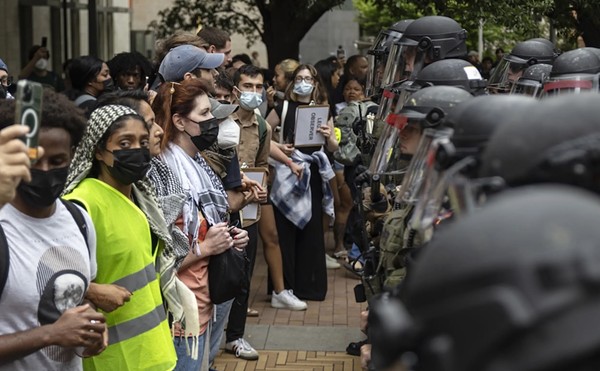Redistricting is here!
Hey Texans, raise your hand if you’ve recently been frustrated with all the heated partisan debate in this country ... frustrated that we’re not seeing enough of it here in the Lone Star State what with our part-time legislature recessed until 2011. Our great state senators and reps have largely been sidelined from such charming GOP v. Dem debates as immigration law, public-school dogma, and celebrating Sarah Palin’s birthday with a statewide wild-game hunt. Well, cool your jets, or maybe fire ’em up, because as our State Rep. Mike Villarreal reminded us Monday, 2011 is a redistricting year.
With a population the state demographer estimates will come in at more than 25 million, Texas is poised to pick up as many as four U.S. congressional seats. If everything goes as planned, the redistricting committee will present new district maps by the end of next year’s legislative session.
Villarreal (D-123) is vice chair of the Redistricting Committee, which joined the Judiciary and Civil Jurisprudence Committee in kicking off a redistricting road show at UTSA’s downtown campus Monday morning. Members of both committees heard testimony from U.S. Congressmen Charlie Gonzalez and Lamar Smith, both intent on conveying that they do not write the district maps. (A dig at twinkle toes Tom DeLay’s missteps in the 2003 process, perhaps?)
A frustrated State Senator Jeff Wentworth (R-San Antonio) reminded the jerks under the Pink Dome that he had been trying since 1993 to pass legislation creating a bipartisan citizen committee to take over the redistricting process instead of it taking up all the legislators’ time one out of every five sessions. Did the jerks listen? Nooooo, though they came this close to getting the bill through a second reading in 2009. Wentworth wanted to give the committee “fair warning” that he’d be re-introducing the bill this session.
Several other citizens gave testimony, including Tommy Calvert Jr., who criticized the dilution of the Eastside voting bloc across three U.S. congressional districts, and MALDEF member Luis Figuerroa, who demonstrated the most in-depth knowledge about Texas’ elephant, er, donkey in the room: Hispanic voters. Nearly 70 percent of the state’s population growth is attributed to Hispanics, said Villarreal, who reminded everyone that in four years Latino Texans will outnumber Anglo Texans.
Groups like MALDEF and the Southwest Voter Registration Education Project were eager to remind state lawmakers that without its Hispanic populations the state would pick up only one new congressional seat, so there better be more brown representation in D.C. as well. One witness mentioned that not only did Hispanics account for 70 percent of Texas’ population growth between 2000 and now, they contributed a similar percentage in the previous decade. “We’re playing catch-up, not for 10 years, but for 20,” said Villarreal when we caught up with him after the hearing. His hope is that a redistricting committee evenly balanced between Democrats and Republicans (which it is currently), will help avoid too much partisan acrimony. “We need balance, but most importantly, we need perspective,” he told us. “We all have to be part of the solution.”
The question both parties will have to answer and refer back to much more frequently than every 10 years is, which is easier, redistricting games to favor your party or inspiring the “minority” voters who will soon make up the majority in most of Texas’ urban and rural areas? If you missed the hearing in San Antonio, but are interested in getting in on redistricting action, the joint committee will hold public hearings on July 19 in McAllen, July 20 in Laredo, and July 21 in Corpus Christi. Also, you may submit written testimony through the chairs of the committees; call representatives Delwin Jones at (512) 463-0542 or Todd Hunter at (512) 463-0672.
Nabbing the rehab $$
The small gathering of Eastside folk at last Saturday’s community meeting at Mt. Zion First Baptist Church was almost evenly split between longtime black residents and white and Latino newcomers (one QueQue reporter, who just bought a house in Denver Heights, included). The pews in the small basement room were far from full — perhaps because of the many Juneteenth activities taking place nearby — but it was a vocal audience. First on the agenda: San Antonio Police Department Captain Mark Witherell, who oversees the Eastside substation and the City Manager’s District 2 Quality of Life taskforce.
A 1983 Harlandale graduate, Witherell recalled hearing rumors of prostitution in the Cherry and Hackberry area when he was in school. A man in the back signaled his hearty assent. “I’m not gonna tell you that it’s gonna be taken care of in 30 minutes,” Witherell said, “because it’s a 30-year problem.” But he cited the stats that the City Manager and Police Chief McManus touted at the June 5 E3 Summit, showing that the district’s crime rate has dropped more than any other area of town. “This is the next Monte Vista, the next King William,” he said, calling the newcomers pioneers. “We don’t want it to be just for the folks who are here. We want to make sure this neighborhood makes everybody grow.”
After the meeting, a man who grew up in the area observed to the QueQue: “There aren’t any poor folks in Monte Vista or King William.” Not so many middle-class folks, either.
The Mayor was careful to emphasize during the E3 Summit that “success is inclusive of the East Side that exists today,” but the City’s initiatives to date haven’t addressed a frustration expressed at the summit’s home-improvement session, where more than one attendee pointed out that what many of the neighborhoods’ elderly and working poor need are grants, not loans. And the City has programs that will help low- to moderate-income citizens address problems ranging from old wiring to broken windows and obsolete water heaters. They’re just full up right now. Residents must be recommended by the Code Compliance department for the Code Compliance Minor Repair program, and there is only funding to do 10 homes through the end of this fiscal year, although Housing and Neighborhood Services expects to get additional funding in the upcoming fiscal cycle. HNSD also has money for 10 homes for the Weatherization Assistance Program, which funds repairs for homeowners who are recommended by CPS and the City for its joint weatherization program.
Perhaps the most helpful program, Owner Occupied Rehab, is already booked, with a list that will roll over into next year’s anticipated $1.8 million budget. The program, which accepts applications, provides up to $65,000 in repairs, anything from foundation to roof, for qualifying low-income homeowners and properties, and can also raze and rebuild homes for willing applicants if rehab is infeasible. But at last week’s Council meeting, the City took more than $700,000 out of its $1.3-million budget for the construction of the Montabella Pointe Apartments affordable-housing project, a development of the SA-based nonprofit Housing & Community Services, Inc. that will be designed specifically with veterans in mind. The 144-unit complex, which will be built on Foster Road in Northeast District 2, also got funds from reserves previously tagged for the Avenida Guadalupe Assocation and the Our Casas Residence Council.
“The window was closing on Montabella,” said Assistant City Manager T.C. Broadnax. Although the transfer of federal grant money from the Owner-Occupied Rehab program “will defer a few jobs on the back end of the process until October,” he said, because the City funds the OOR program “in perpetuity,” no one is really losing out, just moving down the line. Besides, he added, the City put more money into the Owner Occupied Historical Rehab program in May. “They got ’em back,” he said — although homes must be in locally designated historic districts or found to be architecturally significant by the Office of Historic Preservation to qualify for those funds.
That puts us in mind of another part of Captain Witherell’s presentation. His troops are the “weed” part of a two-pronged operation, he said at Saturday’s meeting. “At some point it’s up to City Hall,” he said. “But SAPD will always be here.”
Note: the QueQue was unable to confirm the allocation of additional historic-rehab funding before deadline.
Playing chicken with COSA
Thanks to what Animal Care Services Director Gary Hendel calls the “vagaries of language,” what the City Code says and what it meant to say are not always the same thing. Woe to the commoner chicken lover caught in between.
Last Thursday, City Council passed the new animal ordinance on the consent agenda. Buried in the many pages of changes to tethering laws, “intact” dog fees, etc., was an amendment to the fowl regulations, which reads:
“All domestic fowl must be kept in an enclosure not less than fifty (50) feet from any business building, or dwelling occupied by any person.” By the letter of the law, that means your coop, with your regulation three birds, needs to be 50 feet from your own house as well as your neighbors’ — a feat on inner-city lots, which often run 50x150 or even smaller, before an occupied dwelling swallows up a bunch of square footage. Chicken skyscrapers, perhaps? Or bunkers?
A surprised-sounding Hendel assured us post-vote that’s not what the committee who shaped the new ordinance intended. Assistant City Manager T.C. Broadnax, who oversaw the whole process, echoed those sentiments and assured us that they were already communicating with the City Attorney’s office to see if the language can be tweaked without another trip to Council.
“‘…other than owner’s house’ should have been there,” Broadnax told the QueQue. “Those four words should have been at the end of the sentence.”
Indeed, they’re at the end of the preceding sentence, which establishes that any livestock must be housed at least 100 feet from any occupied dwelling except the owner’s — a patently absurd contrast that should alert code officers to its true meaning, said Hendel: You can have a cow right next to your house, but not chickens?
Both Hendel and Broadnax said the 50-foot rule was meant only for urban chicken farmers who apply for excess-animal permits, not those with the mere three fowl currently allowed. The confusion appears to stem from the section, which is titled “Animal limits; excess animal permit,” and which sets limits on the number of each type of animal a resident can keep, among other things. The subsection on getting an excess-chicken or excess-livestock permit references the preceding subsection about enclosures and dwellings, but an assistant city attorney outside council chambers thought that as written, the new distance regulations include three-chicken coops, too. On the other hand, if Broadnax is right, you could keep up to two llamas damn near anywhere you please in your yard and your neighbors would just have to deal.
Former District 5 City Councilwoman Patti Radle, a 41-year resident of SA’s historically Mexican-American West Side, came to the defense of chicken lovers earlier this week, placing calls to the Mayor’s office to make sure the language gets sorted out. “You couldn’t get a chicken coop 50 feet from your neighbors’ house,” she said. “For us on the West Side, it’s part of the culture. It’s not like we’re inundated with chickens or anything, but it’s just part of the scene.” She was also relieved that the final ordinance language did not ban roosters, as had originally been proposed — there are better ways to crack down on cockfighting than punishing the animal, she said. “Can’t you just see that on Saturday Night Live or the Colbert Report? San Antonio bans roosters?!”
Next week: Callie Enlow moderates between ACS, animal-rights’ proponents, and responsible pet owner advocates.
Takin’ it to the streets at the E-N
More changes are afoot in the Express-News bullpen, but if it can honestly be said that rightsizing is not the same as downsizing, this might be an example of the former. A few folks are on their way out, including News Archivist Regina Hurtado Walla and Education Editor Craig Thomason, but what readers are most likely to notice is that they’ll be seeing more of some bylines they already recognize. In what the suits like to call a “flattening” of the organization (Beep! Beep!), a handful of editors have been recast as reporters, including Greg Jefferson, who was promoted to politics and government editor last year after Jaime Castillo left for City Hall and Scott Stroud claimed Castillo’s columnist position (the latter move causing us to return to our caffeine habit to keep the old pulse rate up). Jefferson will return to the politics beat and also keep his Saturday column. Humorist Roy Bragg, who’s been getting paid to muse out-loud, will have to work again as a print reporter in the newsroom.
One net result is that fewer hands will fiddle with the copy between writer and reader. “We’re eliminating some of the safety net for ourselves,” notes E-N Editor Bob Rivard, and the new system will not be as kind to reporters who are used to sending their rough copy off to someone else’s finishing school or whose relationship with the paper’s stylebook is estranged. “We’re sitting down with reporters on an individual basis and saying, you’re not going to get saved on that anymore.”
These changes pale in comparison to the February 2009 layoffs, which resulted in the loss of 75 newsroom positions, and Rivard is giving them a modestly positive spin.
“Every year, newspapers have seen their ad revenues decline,” he said, and the resulting mandate has been to cut costs. “Fortunately, this time around the cuts are not as bad. … You get to a point where it’s like, what do you cut?”
Hari-kari’s not on the menu, despite rumors that peaked two weeks ago — fueled no doubt by his flirtation with the University of Texas J-school’s top job and an ongoing consolidation of design and production in Houston: Rivard says he’s not taking a buyout. And while they’ll continue to share copy, according to a memo issued to Express-News staff this week, Hearst is reconsidering its San Antonio-Houston consolidation, which could save both jobs and rumors. “The decision to consolidate Express-News editorial production at the Houston Chronicle is under review,” Rivard wrote via email. “A final decision whether to continue with the project or end it should be made soon.”
New Pink Dome press
Whatever comes of Hearst’s machinations, Texans will soon have another news source: The American Independent News Network, a 4-year-old nonprofit chain of politics-oriented websites plans to open a Lone Star bureau in mid July. In addition to its beltway site in Washington D.C., AINN is active in Colorado, Minnesota, Iowa, Michigan, New Mexico, and Florida. News generated by the two-person Texas team (they’re hiring, journos!) will be found along with AINN news from all of its outposts at americanindependent.com, which officially launches this week.
President and CEO David Bennahum, a founding writer at Wired before he launched the pilot program that became AINN, told an Association of Alternative Newsweeklies conference in January that, “We like to be in states with fierce political debate,” so it seems inevitable that they’d land in Texas as immigration, off-shore drilling, and this fall’s elections heat up, despite the presence of the Texas Tribune, Evan Smith’s high-profile foray into new journalism.
Outreach Director Hanaa Rifaey reminded the QueQue that AINN distinguishes itself from many of its competitors by focusing on what they call “impact journalism,” stories and investigative reporting that could change public policy for the better. The majority of AINN’s funding comes from foundations, with a small portion drawn from advertising revenues. “As seemingly everyone is in this economy, we are looking for ways to diversify our funding streams,” Rifaey wrote via email.
Bennahum eschews some of the common wisdom on the Wild Web: His sites produce and aggregate exclusively original content (although they do engage in some blog commentary), and they don’t look to traffic to measure success, because, he told the AAN conference, “relying on traffic measurement doesn’t solve the problem of funding serious reporting and analysis.” •

















